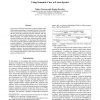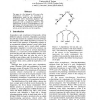120
Voted
EMNLP
2011
14 years 8 days ago
2011
We present a quasi-synchronous dependency grammar (Smith and Eisner, 2006) for machine translation in which the leaves of the tree are phrases rather than words as in previous wor...
117
Voted
EMNLP
2011
14 years 8 days ago
2011
We present new training methods that aim to mitigate local optima and slow convergence in unsupervised training by using additional imperfect objectives. In its simplest form, lat...
125
Voted
AAAI
2011
14 years 16 days ago
2011
We present a method for dependency grammar induction that utilizes sparse annotations of semantic relations. This induction set-up is attractive because such annotations provide u...
86
Voted
COLING
1996
15 years 1 months ago
1996
The paper is a first attempt to fill a gap in the dependency literature, by providing a mathematical result on the complexity of recognition with a dependency grammar. The paper d...
96
Voted
EACL
2003
ACL Anthology
15 years 1 months ago
2003
ACL Anthology
Topological Dependency Grammar (TDG) is a lexicalized dependency grammar formalism, able to model languages with a relatively free word order. In such languages, word order variat...
120
Voted
FLAIRS
2006
15 years 1 months ago
2006
Extensible Dependency Grammar (XDG) is new, modular grammar formalism for natural language. An XDG analysis is a multi-dimensional dependency graph, where each dimension represent...
92
Voted
LREC
2010
15 years 2 months ago
2010
This paper presents the development of an open-source Spanish Dependency Grammar implemented in FreeLing environment. This grammar was designed as a resource for NLP applications ...
118
Voted
NLPRS
2001
Springer
15 years 5 months ago
2001
Springer
Recently, dependency grammar has become quite popular in relatively free word-order languages. We encounter many structural ambiguities when parsing a sentence using dependency gr...
163
Voted
CSLP
2004
Springer
15 years 6 months ago
2004
Springer
Abstract. This article describes an attempt to implement a constraintbased dependency grammar for Czech, a language with rich morphology and free word order, in the formalism Exten...


